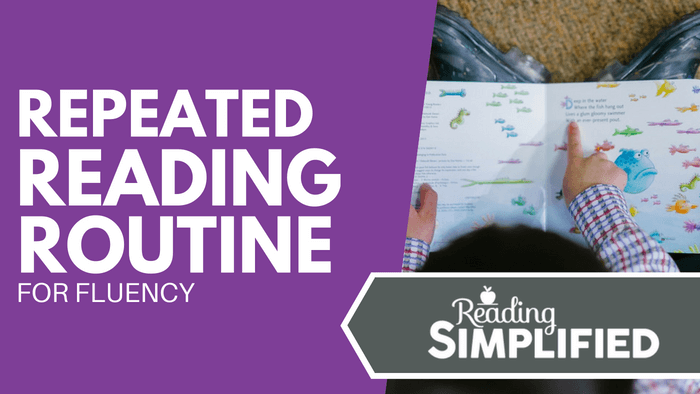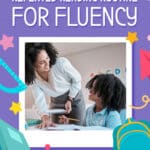
What's the single best indicator of a good reader?
Rapid, or automatic, word recognition. But young readers...and most striving readers...utterly and totally lack automatic word recognition.
There are thousands of activities that can boost automatic word recognition. Yet, one has been shown through research to be the best activity for rapidly building word recognition speed: re-reading practice.
And what if I told you there was a repeated routine that has the power to double or even TRIPLE the words your kids learn in one week?
It’s true!
I’m going to show you a Repeated Reading Routine that will help kids recognize more and more words automatically. On top of this, this re-reading routine will also help develop students' decoding skills, fluency, and even comprehension.
Sound good?
Great! Let’s talk about why repeated reading is so important (in case you need convincing!)
{To watch a video of my repeated reading routine, hit play below}
Why is a Repeated Reading Routine so Important?
Repeated reading gives kids the confidence and motivation to read fluently and process words automatically.
Research shows that repeated reading paired with guidance and feedback from peers, parents, or teachers are effective in improving a variety of reading skills. According to the U.S. National Reading Panel report, re-reading helps improve students’ overall reading ability and makes words “stick.”
There’s no doubt that repeated reading is a powerful benefit to kids of all stripes, so how can you maximize impact of this strategy?
I talked about the importance of strategic practice in oral reading in my previous blog post, but now I’m going to discuss the three stages of re-reading for rapid growth – so hold onto your hats and let’s jump straight in!
Stage 1: During Guided Reading/Small Group Instruction
Re-reading begins with small group instruction where the teacher matches the text selection to the Word Work based on the target sound. This is especially important in the beginning when kids are new to the decoding system. If you’re targeting the short “a” or “i,” choose a selection of text that also focuses these sounds.
Next, have your students take turns reading aloud new text with coaching from the teacher. This gives each child a chance to read out loud with the teacher’s feedback.
One-to-one coaching helps students decode and get better with word identification. However, it’s also essential that the teacher holds all of the other students accountable by making sure they’re following along with eyes on print.
After each child has read, it’s time for the teacher to model a slow (but expressive) read. Kids gain a second exposure to the words before moving onto the third reading session, which involves students chorally re-reading the passage together.

Stage 2: During Literacy Centers/Independent Time
After working with a teacher, the students are ready to do some independent reading. The goal is to have the students re-read the day’s passage until it’s MASTERED.
The time it takes for a student to master the text will vary from student to student. Some kids might get it within their first few tries while other kids will need more practice before they’ve mastered the text - and that’s okay!
Remember – the goal is to encourage your students to get enough repetition, so they can master the text and move onto a new text!
Don’t forget to have your students re-read passages from previous days to review. Yes, you want them to master the new text of the day, BUT you also need to make sure they can re-read previous texts.
TIP – It’s helpful to keep previous passages in the same binder for each student. Or, maybe the students have their own binders in which case, you can hand out a PDF of the passages for the kids to take home and practice with a parent or independently.
Techniques to Support Re-Reading Success
Some kids may find all this repeated reading routine uninspiring.
Here are a few tips and ways that you can make re-reading more feasible and enjoyable for your students:
- Buddy reading
- Listening along with a CD, computer or tablet
- Support from a teaching assistant, volunteer or older student
- Students recording themselves on tablet/iPad (perhaps submitting to Seesaw or Showbie for the teacher to review)
- Students timing themselves to chart their progress
- Students preparing for a presentation reading to a group or class (including readers’ theatre)
- Students read at home with parental support
Stage 3: Next Day During Guided Reading/Small Group Instruction
The third and final step takes place the following day when you expect the kids to come to the reading table having mastered the text. Of course, this doesn’t always happen, and some kids will need more support and practice before they’ve learned the text.
Ask the students to re-read yesterday’s passage chorally and some individually. Keep an eye on your students to identify which kids may need some extra help to catch up with the rest of the group.
This is the stage where the accountability of learning really kicks in. It’s an excellent assessment, and by having kids re-read the same passage they read the previous day, you can see if they’re fluent or not. If not, they may need some more practice and encouragement before they can master the text.
Research Minute – "Fluency intervention that focus on repeated reading of text, opportunities to practice reading in the classroom, and reading a range of texts can generally improve students' fluency and comprehension."
-- (2014) Improving Reading Outcomes for Students with or at Risk for Reading Disabilities: A Synthesis of the Contributions from the Institute of Education Sciences Research Centers.
Benefits of this Repeated Reading Routine
This re-reading routine for rapid growth is incredibly beneficial for teaching kids those all-important high frequency words. Repeated reading has a string of positive effects on reading achievement, fluency and even reading comprehension.
Again, here are the main benefits of this repeated reading routine:
- Improves word identification
- Increases reading fluency
- Develops decoding skills
- Helps students gain confidence
- Improves reading comprehension
Let me know if you try out our repeated reading routine and share your results!



This has given me insight into the use of repeated reading . I will follow the procedure thatcyou have given. Thank you.
Wonderful! Let us know what happens Annette…
I would like to know the difference between Repeated Reading and Echo Reading.
Julia, there are many ways to do both repeated reading and echo reading. In the Reading Simplified system, we don’t do much echo reading, although it can be a useful strategy at times. In our approach, the children 1st decode a text with the teacher’s support during Guided Oral Reading. Then the teacher reads the passage back to them slowly, once or twice. Finally, the students re-read it in a small group, pairs, or with adult help several times. The goal is to return the following day almost fluent with the text selection.
Call love the idea but I’ve got one question. I’m thinking gradual release so why would not the teacher model first?
The teacher has already modeled the process of reading aloud to the child. So each new day it is not necessary to begin at the beginning of the gradual release model.
We want the child to be challenged to work hard on his/her own to attack unfamiliar words. This hard work is the most powerful way to get the words to “stick,” or orthographically map.
But after the first run through, and the student’s hard work, it’s helpful to have the teacher read it aloud, slowly, for the student. This gives the student a slight mental break, but they are still seeing the words as they hear them. Does this make sense?
Where can I get samples of things to use for repeated reading
Late first grade skills
Any text that you’re working on with the child can be a source for re-reading for fluency practice. We begin with our mostly decodable texts inside the Reading Simplified Academy.
After our students cracked the code and know enough high frequency words, then we begin using QuickReads texts which are specially developed to build up high frequency word identification (and knowledge).